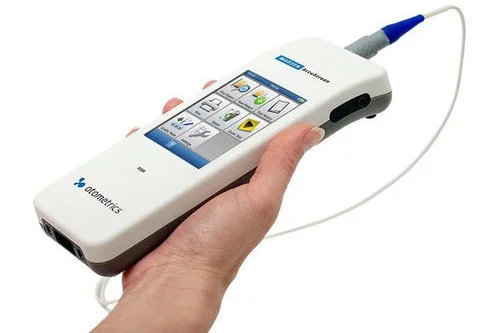Description
Otoacoustic Emissions (OAE) Hearing Tests: A Comprehensive Overview
Otoacoustic Emissions (OAE) testing is a quick, non-invasive, and objective way to screen for hearing loss, particularly in newborns and infants, but also valuable for adults. This test assesses the function of the outer hair cells in the inner ear, which are crucial for hearing. Unlike traditional hearing tests that rely on a patient's response, OAEs measure the sounds produced by the inner ear itself.
What are Otoacoustic Emissions?
Otoacoustic emissions are faint sounds generated by the inner ear. These sounds are a byproduct of the active process of the outer hair cells amplifying sounds. Healthy outer hair cells produce measurable OAEs, while damage to these cells results in weaker or absent emissions.
Types of OAE Tests:
There are two main types of OAE tests:
- Transient-Evoked Otoacoustic Emissions (TEOAEs): This test uses brief clicks or tone pips to stimulate the inner ear. The response is a series of echoes that are measured. TEOAEs are sensitive to a wide range of hearing loss, providing a general assessment of outer hair cell function.
- Distortion-Product Otoacoustic Emissions (DPOAEs): This test uses two different pure-tone stimuli presented simultaneously. The inner ear creates a distortion product—a third sound at a frequency different from either of the original tones. The presence and amplitude of this distortion product indicates outer hair cell function. DPOAEs are more sensitive to certain frequencies and types of hearing loss, offering a more specific assessment.
Who Should Undergo OAE Testing?
OAE testing is particularly beneficial for:
- Newborns and Infants: Early detection of hearing loss is crucial for optimal language development. OAE testing is a key component of newborn hearing screenings.
- Children: It can help identify hearing problems that may not be apparent through behavioral tests.
- Adults: OAE testing can be used to supplement traditional hearing tests, providing additional information about the cause and location of hearing loss.
- Individuals with suspected inner ear disorders: OAEs can help assess the integrity of the cochlea.
Advantages of OAE Testing:
- Non-invasive: No probes or needles are involved.
- Quick and painless: The test takes only a few minutes.
- Objective: The results are not influenced by the patient's cooperation or understanding.
- Suitable for all ages: From newborns to adults.
- Cost-effective: OAE testing is relatively inexpensive compared to other hearing assessments.
Limitations of OAE Testing:
- Middle ear problems: Fluid or other issues in the middle ear can interfere with the test results.
- Not a comprehensive hearing test: OAE testing primarily assesses the outer hair cells and doesn't provide a complete picture of overall hearing ability. A full audiological evaluation is often necessary for a complete diagnosis.
- Cannot detect all types of hearing loss: OAE testing is less sensitive to certain types of hearing loss, such as those affecting the inner hair cells or auditory nerve.
What to Expect During an OAE Test:
The test involves placing a small probe in the ear canal. The probe emits sounds and measures the responses from the inner ear. The procedure is generally painless and well-tolerated by patients of all ages.
In Conclusion:
Otoacoustic emissions testing is a valuable tool for screening and diagnosing hearing loss. While not a replacement for a complete audiological evaluation, OAE testing provides a quick, objective, and non-invasive assessment of inner ear function, making it an essential part of comprehensive hearing healthcare. If you have concerns about your hearing or the hearing of a loved one, consult with an audiologist to determine if OAE testing is appropriate.
